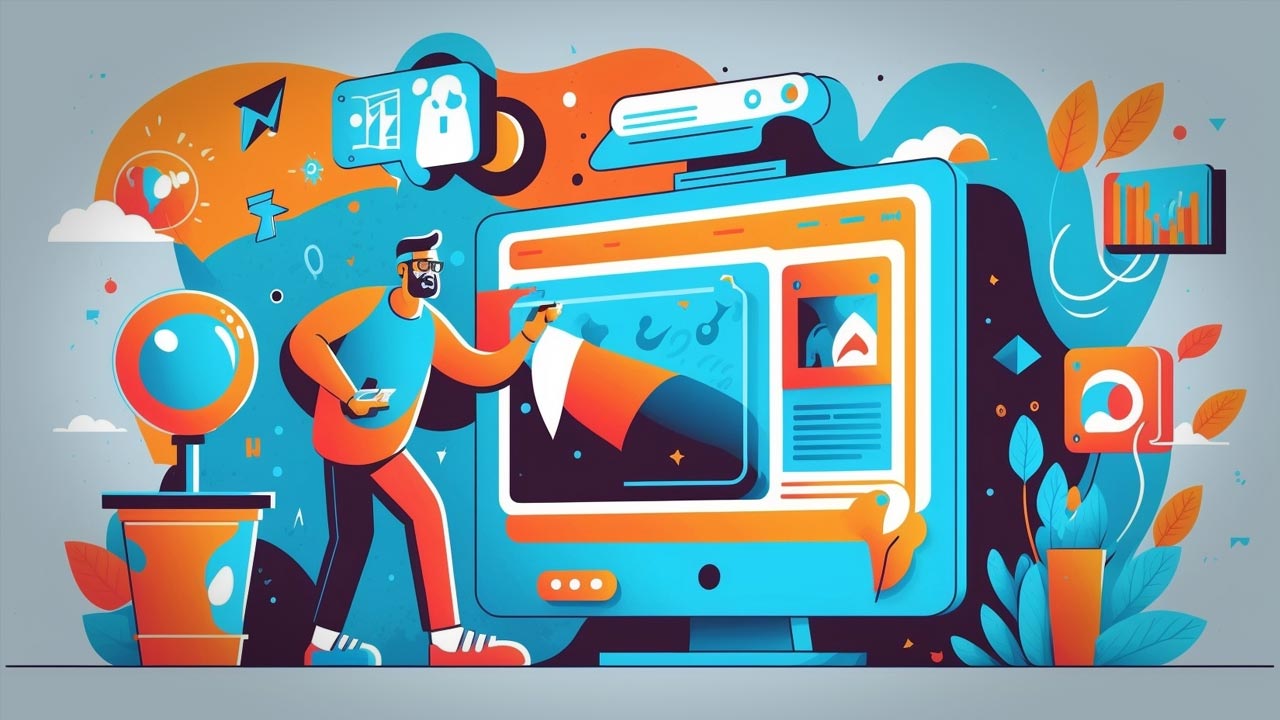Introduction
In an era defined by the digital revolution, the way we live, work, and do business has been drastically altered. At the center of this transformation is digital marketing, a force reshaping the face of business and customer engagement.
So, what exactly is digital marketing?
Digital marketing is the practice of promoting products or services using digital channels, primarily the internet. This can include everything from website promotions, email campaigns, and content marketing, to social media advertising and beyond. It’s about connecting with your audience in the right place and at the right time, in the digital space where they spend a majority of their time.
One of the most striking things about digital marketing is its dynamic and evolving nature. As technology advances and consumer behaviors change, so too do the strategies and tactics employed in digital marketing. It’s a far cry from traditional marketing methods, which were largely static and one-directional.
In digital marketing, interactivity is key. It’s not just about broadcasting a message to your audience; it’s about sparking conversations, building relationships, and creating engaging experiences that resonate with your audience.
Take a moment to think about how often you interact with brands online. Perhaps you follow your favorite brands on social media, read their blogs, or subscribe to their newsletters. All these touchpoints are part of a brand’s digital marketing strategy designed to catch your attention and keep you engaged.
But it’s not just about engagement. One of the key strengths of digital marketing is its ability to track and measure results in real time. This allows businesses to understand what’s working and what’s not, and to adjust their strategies accordingly. This level of insight and flexibility is almost unthinkable in the world of traditional marketing.
In the following sections, we will delve deeper into the world of digital marketing, exploring its different types, its importance in today’s business landscape, and how to develop a successful digital marketing strategy. So, are you ready to embark on this digital journey?
Table of Contents
The Rise of Digital Marketing
The shift from traditional to digital marketing didn’t happen overnight. It was the result of a combination of technological advancements and changes in consumer behavior.
The Evolution of Marketing
Marketing as a concept has always revolved around connecting with customers at the right place and the right time. Traditionally, this meant radio, TV, and print ads. However, the dawn of the digital age brought about a significant shift. The internet started to become more accessible to the average person in the 1990s. Businesses soon realized that their customers were spending less time consuming traditional media and more time online. This led to the birth of digital marketing.
From the early forms of digital marketing in the form of email newsletters and banner ads, the discipline has evolved dramatically. Today, the world of digital marketing includes everything from sophisticated email marketing campaigns to search engine optimization, content marketing, social media marketing, influencer marketing, and more.
The Impact of the Internet
The internet has been a game-changer for businesses and customers alike. Today, consumers have a wealth of information at their fingertips, enabling them to make informed purchasing decisions. They can research products, compare prices, and read reviews, all without leaving their homes.
For businesses, the internet has opened up new avenues for reaching customers. With digital marketing, businesses are no longer bound by geographical limitations. A small business in a remote town can sell its products to customers across the globe.
Furthermore, the rise of social media platforms and mobile devices has only accelerated the shift towards digital marketing. Social media provides a platform for businesses to engage directly with their customers, while mobile devices mean that customers can interact with businesses anytime, anywhere.
The Role of Data in Digital Marketing
One of the key drivers behind the rise of digital marketing is data. In the past, businesses would run a newspaper ad or a TV commercial and hope for the best. There was no concrete way to know how many people saw the ad, let alone how many were influenced by it.
In contrast, digital marketing provides businesses with a wealth of data. They can track how many people saw an ad, how many clicked on it, and how many made a purchase. This allows businesses to measure the effectiveness of their marketing campaigns and make data-driven decisions to improve their strategies. Isn’t it incredible how far we’ve come?
In conclusion, the rise of digital marketing has transformed the way businesses reach and engage with their customers. With its ability to reach a global audience, provide measurable results, and offer personalization, digital marketing is here to stay. So, are you ready to embrace the digital revolution?
The Evolution of Marketing
Marketing as a practice has been around for centuries, but its methods and techniques have evolved dramatically over time.
In the earliest days of commerce, marketing was about survival. It was about finding the best places to sell goods and services. This is often referred to as the “production era,” where the focus was solely on the product and its production, and marketing was simply a means to sell what was produced.
As competition grew with the advent of the industrial revolution, businesses began to realize the importance of marketing their products more effectively. This period, known as the “sales era,” was characterized by aggressive sales techniques as businesses tried to outdo each other in a bid to sell their products.
Then came the “marketing era” in the mid-20th century. Businesses started realizing that understanding consumer needs and wants was crucial to their success. This led to the development of the marketing concept, which emphasizes the importance of customer satisfaction. Businesses began to focus on creating products and services that fulfilled the needs of their customers, rather than trying to sell what they had.
With the rise of the internet and digital technologies in the late 20th century, we entered the “digital marketing era.” Digital marketing brought about a seismic shift in how businesses connect with consumers. It’s no longer a one-way street where businesses broadcast their messages to consumers. Instead, it’s a two-way conversation. Businesses can engage with their customers in real time, get instant feedback, and tailor their offerings to meet individual customer needs.
Moreover, digital marketing has leveled the playing field for businesses. In the past, large businesses with big budgets dominated the marketing landscape. But with digital marketing, even small businesses with limited budgets can reach a global audience.
Today, as we’re moving towards a more connected and data-driven world, we’re entering a new phase in marketing. This phase, often referred to as the “data-driven marketing era,” is characterized by the use of data and analytics to understand consumer behavior and personalize marketing efforts.
So, as you can see, the world of marketing has come a long way. From focusing solely on products to creating customer-centric experiences, it’s a field that’s constantly evolving to meet changing consumer needs and technological advancements. And that’s what makes it so exciting!
The Impact of the Internet
The internet’s emergence has revolutionized nearly every aspect of life, and marketing is no exception. Its impact has been so profound that it has fundamentally changed how businesses market their products and services and how consumers interact with brands.
Global Reach and Accessibility
Before the internet, businesses were largely limited to their local markets. The cost and logistics of reaching a global audience were prohibitive for all but the largest corporations. However, the internet has removed these barriers. Today, even a small business operating out of a home office can market its products or services to consumers around the world. This global accessibility has dramatically expanded the potential customer base for businesses of all sizes.
Personalization and Targeting
The internet has also given rise to unprecedented levels of personalization in marketing. In the past, businesses had limited options for customizing their marketing messages. They could segment their audience by broad demographic categories, but this was a crude tool at best.
With the internet and the rise of digital marketing, businesses can now tailor their messages to individual consumers based on their specific interests, behaviors, and needs. This ability to target marketing efforts has not only improved the effectiveness of these efforts but also enhanced the customer experience. Consumers now expect businesses to understand their needs and provide personalized experiences.
Cost-Effectiveness and ROI
Digital marketing, powered by the internet, is significantly more cost-effective than traditional marketing methods. Businesses can reach a larger and more targeted audience for a fraction of the cost of a TV, radio, or print ad. Moreover, digital marketing’s inherent measurability allows businesses to accurately track their return on investment (ROI) and adjust their strategies to maximize results.
Interactivity and Engagement
Perhaps one of the most profound impacts of the internet on marketing is the shift from a one-way conversation to a two-way dialogue. Businesses can now interact with their customers in real time, foster relationships, and build brand loyalty. This interactivity has turned customers from passive recipients of marketing messages into active participants in the brand’s narrative.
Data and Insights
Finally, the internet has given businesses access to a wealth of data about their customers. This data, when properly analyzed and interpreted, provides valuable insights into consumer behavior and preferences. Businesses can use these insights to make data-driven decisions and continually refine their marketing strategies.
In conclusion, the internet’s impact on marketing has been transformative. It has expanded the reach of businesses, enabled personalization, improved cost-effectiveness, fostered interactivity, and provided access to invaluable data and insights. And as the internet continues to evolve, so too will its impact on marketing.
Understanding the Different Types of Digital Marketing
In today’s digital age, marketers have a multitude of platforms and techniques at their disposal. Let’s dive into some of the most common types of digital marketing:
Search Engine Optimization (SEO)
SEO involves optimizing your online content so that a search engine likes to show it as a top result for searches of a certain keyword. The goal is to attract visitors to your website when they search for products, services, or information related to your business. Can you imagine the impact of being on the first page of search results?
Content Marketing
Content marketing is all about storytelling. It involves creating and distributing valuable, relevant, and consistent content to attract and engage a clearly defined audience, with the ultimate goal of driving profitable customer action. This could be anything from blog posts and videos to ebooks, infographics, and podcasts. After all, who doesn’t love a good story?
Social Media Marketing
Social media marketing is exactly what it sounds like: using social media platforms to promote your products or services. But it’s not just about promoting; it’s about engaging with your audience, building relationships, and establishing trust. And with billions of people using social media, the potential reach is enormous!
Pay-Per-Click Advertising (PPC)
PPC is a method of driving traffic to your website by paying a publisher every time your ad is clicked. One of the most common types of PPC is Google Ads, which allows you to pay for top slots on Google’s search engine results pages at a price “per click” of the links you place. It’s like buying visits to your site, rather than attempting to “earn” those visits organically.
Email Marketing
Email marketing is one of the most effective types of digital marketing. It involves sending emails to prospects and customers with the aim of building relationships, promoting content, discounts, events, and directing people towards the business’s website. Remember, a well-crafted email could be the key to converting prospects into customers.
Affiliate Marketing
Affiliate marketing involves promoting someone else’s products or services and earning a commission when a purchase is made through your referral link. It’s a win-win situation for both parties: businesses get more sales, and affiliates earn money for their promotional efforts.
Influencer Marketing
Influencer marketing involves partnering with influential people in your industry or on social media to reach a larger audience. Influencers can help promote your products or services to their followers, which can lead to increased brand awareness and sales.
In conclusion, there are many different types of digital marketing, each with its own strengths and best uses. A comprehensive digital marketing strategy often includes multiple types, each complementing the others to achieve the business’s goals. As a digital marketer, it’s essential to understand these types and how to leverage them effectively. So, which type of digital marketing will you use for your next campaign?
The Importance of Digital Marketing in Today’s Business Landscape
Digital marketing has become a central part of many businesses’ strategies, and for good reason. The world has become increasingly digital, and businesses must adapt to keep up with these changes. Here’s why digital marketing is so important:
Reaching People Where They Spend Their Time
Today, the average adult spends over 6 hours per day consuming digital media. Whether it’s social media, blogs, videos, or online shopping, people are spending a significant amount of their time online. Digital marketing allows businesses to reach their audience where they’re already spending their time. Can you think of a better way to connect with your customers?
More Cost-Effective Than Traditional Marketing
Digital marketing is more cost-effective than traditional marketing methods. Small businesses often don’t have substantial resources or a lot of capital. Digital marketing provides them with a better and more cost-effective marketing channel that delivers results.
Easy to Measure and Adjust
One of the key benefits of digital marketing is its measurability. With traditional marketing, it’s challenging to know how many people saw your billboard or watched your TV ad. Digital marketing, on the other hand, provides businesses with detailed analytics, so they know exactly how many people saw their ad, clicked on it, and made a purchase. This data allows businesses to measure the effectiveness of their campaigns and adjust their strategies accordingly.
Personalization and Segmentation
Digital marketing allows for unprecedented levels of personalization. Businesses can tailor their marketing messages to specific audiences, ensuring that the right people get the right messages at the right time. This level of personalization and segmentation is not possible with traditional marketing methods.
Greater Engagement
Digital marketing allows businesses to engage with their customers in real time. Whether it’s through social media comments, reviews, or online chats, businesses can have direct conversations with their customers, solving issues and answering questions almost instantly. This helps businesses build relationships with their customers and create a loyal customer base.
Builds Brand Reputation
A well-executed digital marketing strategy can help build a business’s brand reputation. By consistently providing valuable and relevant content, businesses can establish themselves as thought leaders in their industry. This can lead to increased trust and credibility, which can directly impact a business’s bottom line.
In conclusion, the importance of digital marketing in today’s business landscape cannot be overstated. From reaching a larger audience to building brand reputation, digital marketing is a critical tool for businesses to connect with their customers in the digital age. So, are you ready to embrace digital marketing?
How to Develop a Successful Digital Marketing Strategy
A well-structured digital marketing strategy is a road map guiding you towards your business goals. Here are the steps to develop an effective strategy:
Define Your Goals
Every successful strategy begins with clear, well-defined goals. What do you want to achieve with your digital marketing efforts? It could be anything from increasing website traffic, boosting sales, growing brand awareness, or improving customer engagement. Make sure your goals are SMART – Specific, Measurable, Achievable, Relevant, and Time-bound.
Understand Your Target Audience
Once you’ve defined your goals, you need to understand your target audience. Who are they? What are their interests? How do they like to consume content? The more you know about your audience, the more effectively you can create content that resonates with them and meets their needs.
Analyze Your Current Digital Marketing Efforts
If you’re already using digital marketing, it’s important to analyze your current efforts. What’s working? What’s not? Use tools like Google Analytics to get data on your website traffic, user engagement, conversion rates, and more. This analysis can provide valuable insights to inform your strategy.
Choose the Right Digital Marketing Channels
Based on your goals and your target audience, you need to choose the right digital marketing channels. These might include SEO, content marketing, social media marketing, email marketing, PPC advertising, and more. Each channel has its strengths and is suited to specific goals and audiences.
Create and Distribute High-Quality Content
Content is king in digital marketing. Create high-quality content that is valuable and relevant to your audience. This could be blog posts, videos, infographics, ebooks, or social media posts. Once you have your content, distribute it through your chosen marketing channels.
Measure and Adjust Your Strategy
Finally, remember that digital marketing is not a set-it-and-forget-it endeavor. You need to regularly measure the effectiveness of your strategy and make adjustments as needed. Keep a close eye on your analytics and use this data to refine your strategy.
In conclusion, developing a successful digital marketing strategy requires clear goals, understanding your target audience, analyzing your current efforts, choosing the right channels, creating high-quality content, and continuous measurement and adjustment. With these steps, you’ll be well on your way to digital marketing success. So, are you ready to create your digital marketing strategy?
Frequently Asked Questions about Digital Marketing
1. Why is digital marketing important?
Digital marketing allows businesses to reach a larger audience, personalize their marketing efforts, and measure results in real time. It’s a cost-effective and efficient way to engage with customers.
2. What are the different types of digital marketing?
The main types of digital marketing are SEO, content marketing, social media marketing, email marketing, and affiliate marketing. Each serves a specific purpose and can be used in conjunction to create a comprehensive digital marketing strategy.
3. How do I get started with digital marketing?
Start by defining your goals and understanding your audience. Then, choose the right platforms, create high-quality content, and monitor your results to adjust your strategy as needed.
4. What is the future of digital marketing?
The future of digital marketing is likely to be defined by personalization, AI, and data analytics. These advancements will allow businesses to tailor their marketing efforts to individual customers and measure their results with greater accuracy.
5. Can small businesses benefit from digital marketing?
Absolutely! Digital marketing allows small businesses to compete with larger ones by reaching a wider audience and tailoring their marketing efforts to their specific audience. With a well-planned strategy, even small businesses can see significant growth with digital marketing.
Final Thoughts
Navigating the digital marketing landscape can be a complex task, but understanding its concepts and strategies is vital for any business in the current digital age. The rise of digital marketing is a direct response to the rapid growth of internet usage, making it crucial for businesses to adapt and thrive.
From understanding the different types of digital marketing and their uses, to recognizing its significance in today’s business scenario, we’ve delved into the heart of digital marketing. We’ve also explored the process of crafting a successful digital marketing strategy, a must-have for any business looking to achieve its goals in the digital space.
Remember, the key to successful digital marketing lies in knowing your audience, delivering valuable content, and continuously measuring and adjusting your strategy. While the digital world is fast-paced and ever-evolving, the core principles of marketing remain: understanding your customers and delivering value.
As we move further into the digital age, the importance of digital marketing is only set to increase. It offers businesses an opportunity to engage with their audience in new and exciting ways. So, are you ready to leverage digital marketing to take your business to new heights?








